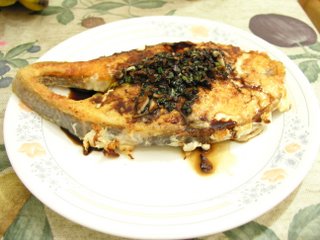Pan Fried Fish Steak
A lot of people find seafood intimidating. I guess pound for pound, it is usually more expensive than other types of meat. If not cooked properly, it might mean having to call the local chinese restaurant for some take out food.
Cooking seafood does not have to be complicated. For now, let's stay away from the lobsters and crabs (that will be for another post) and just stick with more affordable cuts of fish. In an ideal world, we'd always be using the fresh fish that the local market has to offer. But if cost is an issue, frozen fish can offer a tasty alternative. For this post, I used a frozen fish (any one would do).
The first thing to do is season the fish. I use kosher salt and freshly ground pepper. I think this is the simplest way to season meat. You can try to be more adventurous here by adding different types of herbs (dill, parsley, etc), but this is purely optional. The next step is to give the fish some texture. To do this, liberally cover the fish with flour. This way, the fish becomes golden brown when cooked.
In a skillet, put sufficient olive oil to coat the bottom. When the oil is hot, slowly place the fish on the skillet. The thickness of the fish will dictate how long to cook it. This is a challenge to some people, but I don't think you should worry. If I undercook fish, I just pop it in the microwave until it's fully cooked. That's how I save my fish. Make sure there is enough oil left on the skillet when you turn over the fish. If there's not enough, put some more. Without sufficient oil, the flour will burn before the fish is done.
At this point, the fish has a bit of taste, but we can definitely kick the flavour up another level. There are many sauces that can go with this. You can have the fish with your favourite salsa for example. But for this dish, I will share my interpretation of a classic chinese sauce.
In a sauce pan, pour some oil and put some finely chopped garlic and ginger. After the garlic is golden brown (not burnt), pour some soy sauce. There is no exact measurement for the amount of soy sauce, but this will depend on how big the fish is. Usually you'd want enough sauce to cover the fish, but not too much sauce that the fish is swimming in it. Add a tablespoon of sesame oil and chopped green onions for added flavour. Pour over the fish and enjoy.
Cooking seafood does not have to be complicated. For now, let's stay away from the lobsters and crabs (that will be for another post) and just stick with more affordable cuts of fish. In an ideal world, we'd always be using the fresh fish that the local market has to offer. But if cost is an issue, frozen fish can offer a tasty alternative. For this post, I used a frozen fish (any one would do).
The first thing to do is season the fish. I use kosher salt and freshly ground pepper. I think this is the simplest way to season meat. You can try to be more adventurous here by adding different types of herbs (dill, parsley, etc), but this is purely optional. The next step is to give the fish some texture. To do this, liberally cover the fish with flour. This way, the fish becomes golden brown when cooked.
In a skillet, put sufficient olive oil to coat the bottom. When the oil is hot, slowly place the fish on the skillet. The thickness of the fish will dictate how long to cook it. This is a challenge to some people, but I don't think you should worry. If I undercook fish, I just pop it in the microwave until it's fully cooked. That's how I save my fish. Make sure there is enough oil left on the skillet when you turn over the fish. If there's not enough, put some more. Without sufficient oil, the flour will burn before the fish is done.
At this point, the fish has a bit of taste, but we can definitely kick the flavour up another level. There are many sauces that can go with this. You can have the fish with your favourite salsa for example. But for this dish, I will share my interpretation of a classic chinese sauce.
In a sauce pan, pour some oil and put some finely chopped garlic and ginger. After the garlic is golden brown (not burnt), pour some soy sauce. There is no exact measurement for the amount of soy sauce, but this will depend on how big the fish is. Usually you'd want enough sauce to cover the fish, but not too much sauce that the fish is swimming in it. Add a tablespoon of sesame oil and chopped green onions for added flavour. Pour over the fish and enjoy.


0 Comments:
Post a Comment
<< Home